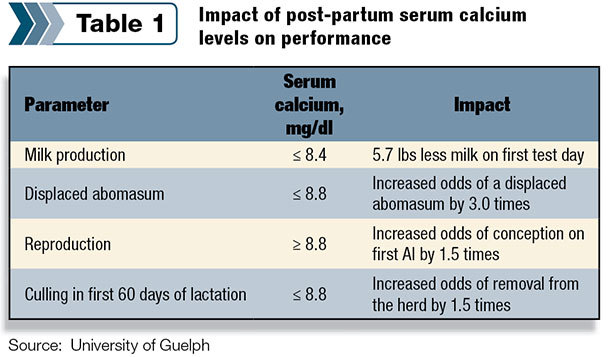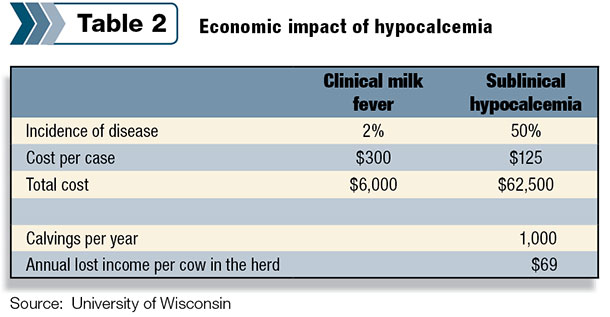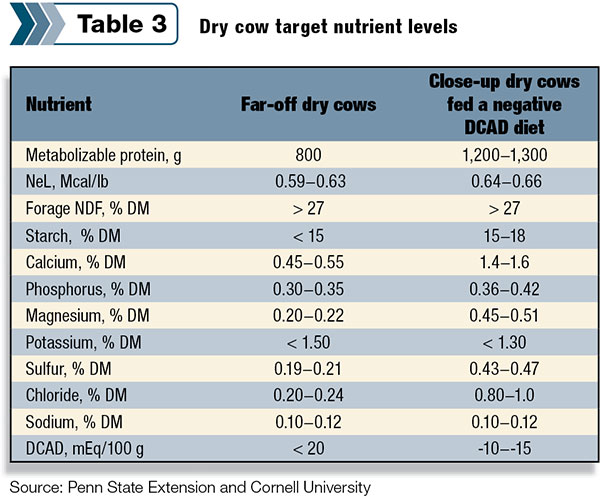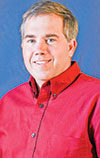In baseball, team batting average is a great indication of how successful a team will be. The major league teams that play in the World Series have some of the best batting averages in the league.
Interestingly, the differences among the teams are relatively small and minor improvements – such as shifting hand position on a bat – have a huge impact on a team’s success.
Much like batting averages in baseball, calcium status in fresh cows can be greatly influenced by small adjustments in management, mineral content of the diet and lowering the dietary cation-anion difference (DCAD).
These small changes can ultimately result in significant positive benefits in cow health and lactation performance. Researchers have shown a link between serum calcium levels in fresh cows and milk yield, metabolic diseases, reproductive performance and the risk of being culled early in lactation.
Calcium requirements
Late in gestation, a cow’s requirement for calcium increases as it begins to make colostrum. The cow’s demand for calcium continues to increase after calving and starting to produce greater volumes of milk. Unfortunately, in late gestation and early lactation, cows tend to have low dry matter intakes, which compound the calcium deficiency during early lactation.
As a result, when a cow’s requirement for calcium is increasing, the amount of calcium it is consuming is typically lower than its requirement.
To compensate for the difference between requirement for calcium and dietary calcium intake, a cow can utilize some of the calcium stored in its bones. Still, there is a period of time around calving when the amount of calcium a cow consumes and the calcium the cow removes from its bone is less than its requirement.
When this occurs, the cow experiences a condition called hypocalcemia, which is defined as a serum calcium concentration below 8.5 milligrams per deciliter (mg per dl).
If the difference between a cow’s supply of calcium and its requirement for calcium is great enough, the cow will experience clinical hypocalcemia (milk fever), which generally occurs when serum calcium concentrations drop below 5.5 mg per dl. The goal is for cows to return to normal serum calcium levels (8.5 to 10.4 mg per dl) in the first 48 hours after calving.
Consequences of low serum calcium concentrations
One common way to evaluate a cow’s calcium status is to measure the concentration of calcium in blood serum. Researchers from the University of Guelph assessed the relationship between serum calcium concentrations in the first week of lactation and several health, production and reproductive measures (Table 1).

In addition, researchers have linked low serum calcium concentrations postpartum to an increased incidence of metritis and ketosis. For these reasons, subclinical hypocalcemia is considered a gateway disease because cows that experience subclinical hypocalcemia are at risk for other metabolic diseases.
Compounding costs of low serum calcium concentrations
The estimated cost of clinical hypocalcemia is $300 per case, which includes the cost of treatment, milk loss and replacement of cows that do not recover from treatment. The estimated cost of subclinical hypocalcemia is $125 per case, which includes the cost of lost milk and the direct costs associated with the increased risk of ketosis and displaced abomasum.
The incidence of clinical hypocalcemia in North America is less than 4 percent, but the incidence of subclinical milk fever is more than 50 percent. Table 2 shows the potential cost of clinical and subclinical milk fever in a 1,000-cow herd.

In this example, the estimated cost of clinical milk fever is $6,000 per year, the cost of the subclinical disease is more than $60,000, and the total lost income per cow in the herd is $69 per year.
Tips for enhancing fresh cow serum calcium status
Top managers recognize that improving calcium status in their herds can result in improved profitability. These managers make feeding and management strategies designed to reduce the impact of hypocalcemia a priority. Consider these key strategies for improving serum calcium status of fresh cows, which may enhance transition cow health and performance:
1. Encourage dry matter intake in late gestation and early lactation.
- Avoid overcrowding close-up dry cow and fresh cow pens by not exceeding an 80 percent stocking density (eight cows for every 10 freestalls).
- Provide a minimum of 30 inches of feedbunk space per cow.
- Avoid excess pen moves. Dry matter intake drops for up to three days each time a cow moves to a new pen.
- When possible, keep springing heifers and mature cows in separate pens.
- Feed a palatable ration that encourages heifers and cows to consume more than 26 and 28 pounds of dry matter per day, respectively.
- Minimize the time cows spend in maternity pens, ideally moving them to these pens just in time for calving.
- When cows are moved to maternity pens, provide fresh feed and water.
2. Feed dry cows a ration balanced to meet their nutritional needs and increase the likelihood of a successful transition to their next lactation. (Table 3).

3. Feed a negative DCAD diet using a palatable source of anions for a minimum of 21 days prior to calving. Research shows that cows fed a diet with a negative DCAD diet that drops urine pH below 6.0 have an improved calcium status after calving.
Dairy producers, like MLB teams, may also create an impressive batting average as they contend for improvements in calcium status, herd health and productivity. PD
Scott Bascom, Ph.D., is a dairy technology manager with Phibro Animal Health Corporation with 20 years of experience as a dairy cattle nutritionist.

-
Scott Bascom
- Dairy Technology Manager
- Phibro Animal Health Corporation
- Email Scott Bascom






